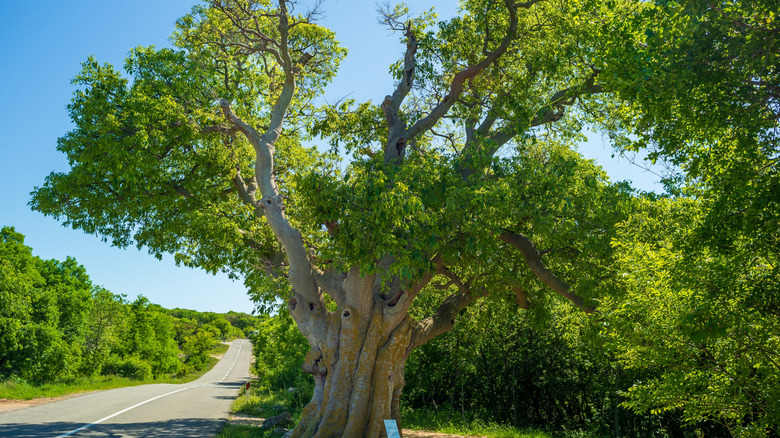The Sweet Fruit Tree That Is A Better Alternative To Hackberry Tree
If you live in the southern parts of the country, you might have long admired the majestic hackberry tree (Celtis occidentalis) but discovered it won't really grow in your region, especially if you live in USDA hardiness zone 10. Lucky for you, there's a southern alternative known as the sugarberry (Celtis laevigata), which can be grown in zones 5 through 10. Both these species share similar characteristics, but the sugarberry differs in that it has sweeter and juicier fruit and leaves that are longer with a slender tip. The bark of the sugarberry is also less warty and has corky ridges, which give the trunk an interesting appearance during winter. While these differences don't particularly make it a better alternative to the hackberry, the fact that you can grow a sugarberry in zone 10 and that it has greater resistance to diseases like witches broom do.
The sugarberry makes a lovely shade tree and will also attract butterflies to your yard as it's a larval host for various species, including the American Snout, Tawny Emperor, and Question Mark butterflies. The edible berries or drupes are also a favorite food source for birds and small mammals, and you'll be delighted to find some common birds visiting your garden in winter if you decide to plant one of these trees. This is a large tree that can reach a height of up to 70 feet with a spread of around 60 feet, so you need to allow plenty of room for it to grow.
Caring for the sugarberry tree in your yard
Before you get ready to plant one of these outstanding trees in your yard, there are a couple of things to be aware of. Firstly, it does have surface roots that can create problems if the tree is grown near structures or walkways, so this is one species you shouldn't grow right next to your house. Problems can also arise if it's grown in the middle of the lawn because the tree is prone to injury from things like mower blades and brush cutters. You also need to be vigilant in pulling up any random seedlings that may pop up from the tree's self-seeding tendency so you don't end up with a tree growing in an unsatisfactory spot.
While there are some species of fast-growing trees you don't want to plant in your yard, the sugarberry can make a lovely addition to your landscape. It can be grown in full sun or part shade and is not that fussy about soil. It can even handle areas that occasionally flood and has good drought and salt tolerance. Just be aware that if you plant it anywhere near a path or driveway, you might have to deal with the cleanup from dropped fruits and seeds. If you're growing it as a shade tree, the branches will start to droop as it grows, so these will need to be pruned regularly. While this species is generally resistant to witches broom, it could succumb to trunk rot if it suffers damage to its thin bark.

